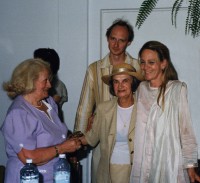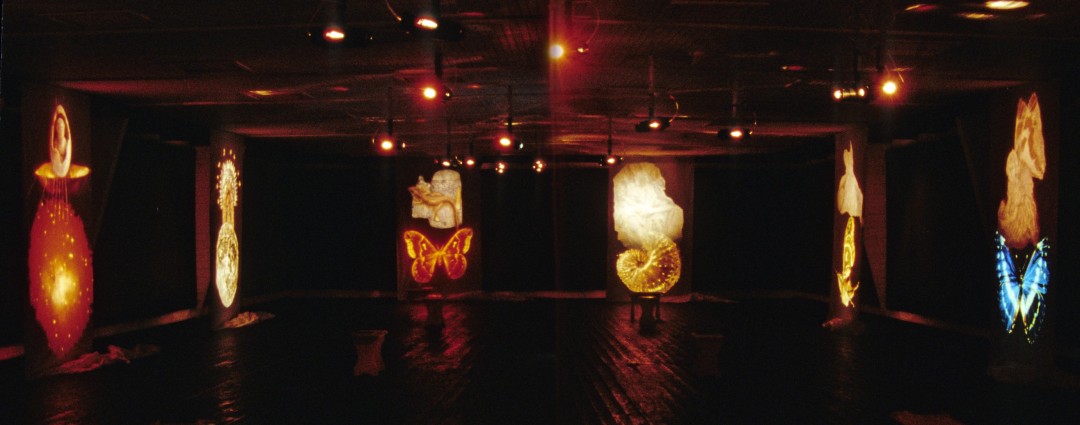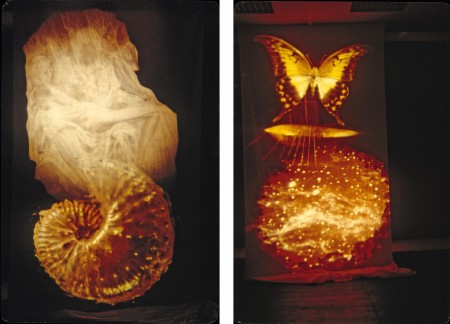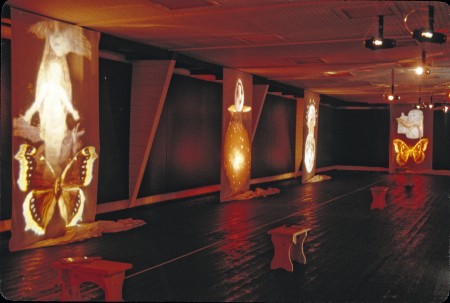Conversations with Angels
Majdanek, Lublin Poland, Summer 2003
Dedicated to the Women of Barrack 9
 Majdanek, a former Nazi concentration camp near Lublin in Poland where 235 thousand perished, is for me a place where one encounters an incomprehensible darkness. As an artist I try to be a light bringer, and believe that art has the capacity to both heal and enlighten. All of my work over a thirty-year period has been involved with the idea of reconciliation, and spiritual transformation. I felt drawn to Majdanek because of a small shrine on the site started by German and Jewish youth, where one can pray and think about forgiveness. It was as if the visitors are given an opportunity to not only think about the site, but to somehow shift and transform the darkness found there into something more positive for themselves and others.
Majdanek, a former Nazi concentration camp near Lublin in Poland where 235 thousand perished, is for me a place where one encounters an incomprehensible darkness. As an artist I try to be a light bringer, and believe that art has the capacity to both heal and enlighten. All of my work over a thirty-year period has been involved with the idea of reconciliation, and spiritual transformation. I felt drawn to Majdanek because of a small shrine on the site started by German and Jewish youth, where one can pray and think about forgiveness. It was as if the visitors are given an opportunity to not only think about the site, but to somehow shift and transform the darkness found there into something more positive for themselves and others.
Leo Tolstoy wrote a book on the practice of nonviolence, and corresponded with Gandhi who read his book. The Jains of India also influenced Gandhi. Gandhi took much of his message of nonviolence from the Jain philosophy of Ahinsa. The Jains practice nonviolence (Ahinsa), and Anakantavada, respect for the multiple truths found in different views. In our world torn apart by violence and sectarianism, these values of tolerance for other views, and nonviolence have an appeal for me. Majdanek is certainly a site that has known some of the worst violence against the human spirit, and a lack of tolerance for a religion, a people, and a culture. As a Catholic, I was deeply moved by the Jain devotion to forgiveness.
Each morning in Puja, Jains ask to be forgiven for all they have done and in return to forgive others. The Jain prayer is, “May I forgive all souls and have them forgive me.” For me Majadanek represents the heart of darkness, a place where all of us could meditate on how to be forgiven for our acts of violence in word and deed. So much of modern culture seems programmed for violence; we now live in a start of perpetual war. A second part of morning puja involves holding a mirror to reflect images of the divine (transcendent Self) into the heart center. The practice presents a way of bringing the divine and forgiveness in our own hearts.
For me this practice is beautifully described in “Talking with Angels”. This book transcribes the conversations with angels experienced by four girls in Hungary between 1943 and 1944. Three of the girls perished in the concentration camps, and the only survivor published the book in 1953. I was very moved by one of the passages and its relationship to the Jain mirror (puja) practice.
“Listen carefully! there is a wonderful mirror in you.
A MIRROR THAT REVEALS ALL!
IT DWELLS INSIDE OF YOU
AND REFLECTS THE DIVINE.
BUT ONLY IN SILENCE.If a tiny mosquito alights on its surface, the mirror is clouded.
If the mirror is not clear, you can not create.
Focus all of your attention on it.
Heaven does not hide before the wonderful mirror.”
My idea was to have the viewer meditate on an image, and reflect it into their heart center using a small mirror. For me the clouding on the mirror is our lack of forgiveness, violence, negative judgment, and lack of compassion.
Most of the images come from my drawings of my dreams, and from the dreams and visions of the women of Barrack 9. The women of Barrack 9 created an imaginary radio, and “broadcast” their dreams using their voices around the camp. These women knew that psyche and spirit are tools for survival in the darkest times. I had a contact with a member of the group they formed after the war; and had writing by the inmates of Barrack 9. A widower of one of the women, Symon Bojko, helped me with the translation.
The piece was dedicated to these brave women of great faith, both Catholic and Jewish. I found the women from Majdanek I met to be some of the most spiritual and beautiful souls I have ever encountered. Their lives provided a meditation on the Self; the transpersonal center of each person, which lies beyond the ego, and is our lamp in the darkness.
For me God often speaks through dreams and visions. Our world has a great deal of violence and darkness. Finding new roads to peace, love, and nonviolence through meditation is one way to honor those who died at Majdanek. By dedicating the piece to the women of Barrack 9 who found a ray of light in the darkness, I tried to make the piece to commemorate their lives. Some of these women who were still living came to the opening.
The barrack used for the installation was the old shoe factory, a space roughly 65 wide by 150 feet long.
I had a series of benches made by the Majdanek carpenters along with a hand mirror mounted to the right of each chair. The mirror reflects an image projected on a scrim in front of the viewer, and the mirror reflects the image into the viewer’s heart center.
The museum is open only in the summer months due to a lack of heating. Each summer thousands of visitors from all over the world come to Majdanek, the best preserved of all of the concentration camps. Each year an artist is invited to do an installation for this visiting international public. The Majdanek staff helped with some of the archival research. The staff electricians also provided help with the wiring. Brochures and mailers were provided by the museum in English and Polish. I raised the funds to pay for the installation from individuals. I had partial funding from the Harriet G. and Estaban Vicente Charitable Trust in the amount of $3,000, $1,000 from Elisabeth Goth, and $500 from the Marjorie Weinberg trust, and Sandra Stephenson gave $300. My total budget was $7,500.
I used 48 projectors without fans I found in an airline magazine; they are used to put Santa on your garage at Christmas. I rewired the projectors and put them on timers. The images were projected on bed sheet woven in the United States prisons. After the project was finished, the sheets were donated to orphanages in Lublin.


